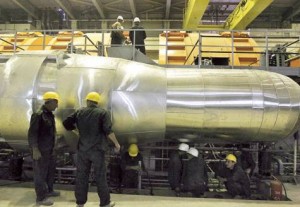By Reuters
(Reuters) - The United Nations' atomic watchdog may decide that less uranium is missing at an Iranian research site than it had previously thought, diplomats say, and that may go some way to easing concerns that it may have been diverted for military use.
U.N. inspectors have asked Iran to explain a "discrepancy" after an inventory they made last year of natural uranium metal and process waste at the Tehran facility showed there was 19.8 kg less than the Iranian laboratory's own count.
The United States is concerned the material may have been diverted to suspected weapons-related research activity. Iran, which says its nuclear program is entirely peaceful, dismissed the reported discrepancy as "absolutely not an issue".
One Western diplomat said it had since been partly "explained" during talks between Iran and the International Atomic Energy Agency (IAEA), the Vienna-based U.N. watchdog, and that discussions on the issue were continuing.
But the details would only become clear in the IAEA's next quarterly report on Iran's disputed nuclear program, expected towards the end of August.
"I've heard that the agency could be revising the figure lower," another diplomat said, referring to the report prepared ahead of a September 10-14 meeting of the U.N. agency's 35-nation board, when Iran is again likely to dominate the agenda.
A third envoy said it was also his understanding that the IAEA's investigation had resulted in a reduction of the discrepancy, but he said the research was not yet complete.
There was no immediate comment from the IAEA or Iran's diplomatic mission in the Austrian capital.
WESTERN CONCERNS
Experts say such a small quantity of natural uranium could not be used to make a bomb, but that the metal could be relevant to weapons-linked tests.
In November last year, the IAEA presented a stash of intelligence indicating that Iran has undertaken research and experiments that could be relevant for developing atomic arms, prompting Western states to ratchet up sanctions on Tehran.
The IAEA said in previous reports that the discrepancy at Jabr Ibn Hayan Multipurpose Research Laboratory (JHL) concerned uranium metal conversion experiments from 1995 to 2002.
Iran has suggested the discrepancy may have been caused by a higher amount of uranium in the waste than had been measured by the U.N. inspectors.
The IAEA said in May that Iran had offered to process the waste material and extract the uranium, but that the agency had offered an alternative way to address the problem.
A senior U.S. official said late last year the issue required "immediate" resolution, citing information indicating that "kilogram quantities" of natural uranium metal had been made available to Iran's military program.
But a European diplomat told Reuters it now seemed to have become less of an issue, unlike the issue of Iran's uranium enrichment program and Western suspicions that Tehran is seeking to develop a capability to make nuclear weapons.
The uranium discrepancy was likely to be "buried more than it is at the moment", another diplomat said.
Iran says it is enriching uranium only as fuel for nuclear power plants, not atomic weapons, but its refusal to curb the activity has drawn increasingly tough sanctions aimed at its oil exports.
Enriched uranium can be used to generate electricity, which is Iran's stated aim, or provide material for weapons if refined much further, as Western states suspect is Iran's ultimate aim.
The Iran Project is not responsible for the content of quoted articles.

 QR code
QR code